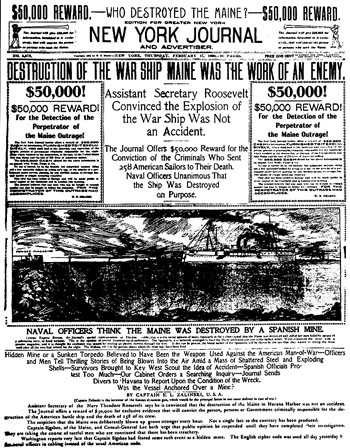The Progressive Era was marked by a reconsideration of the excesses of the Gilded Age. The changing nature of the American economy due to industrialization had placed a high toll on citizens, and its effects were more fully realized at the turn of the twentieth century. Progressive reformers like Robert LaFolette led the demand for new labor laws, increased antitrust enforcement, a new environmentalism and the push for women’s suffrage.
As they did throughout the Gilded Age, newspapers would continue to play an instrumental role in affecting the course of the public’s debate on major issues. Perhaps no issue shows the power of the press at the time better than the issue of the USS Maine.
The USS Maine was a navy battleship stationed in Havana harbor to stand watch over the Cuban revolution against Spain. For reasons that remain unclear, it sank in 1898, and news quickly reached America. Newspaper editors, most notably William Randolph Hearst and Joseph Pulitzer, began an aggressive campaign to push for U.S. intervention in the conflict. They continuously sensationalized the story, an approach that came to be known as yellow journalism that was designed to increased newspaper sales. Hearst would encourage other interventions outside of Cuba, including in Puerto Rico and in the Philippines.
However, the Progressive Era is more often known for its domestic reforms, many of which were spearheaded by intrepid reporters who brought attention to the damage created by the excesses of the Gilded Age. Ida Tarbell is perhaps the most famous reporter of this era, reinventing the notions of investigative reporting with her lurid tales of the rise of the Stanford Oil Company and the dangers to the public of the oil trust. The sensational tale, which was serialized in McClure’s, gave impetus to Roosevelt to increase his anti-trust policies.
 However, it was not just classical journalism that brought the public’s attention, but literature published in newspapers as well. Upton Sinclair wrote about the meatpacking industry in the The Jungle, in which he follows the travails of an Eastern European immigrant family in Chicago. The novel was originally published in the socialist Appeal to Reason newspaper, and while not its original goal, led to significant reform of food and drug laws in 1906.
However, it was not just classical journalism that brought the public’s attention, but literature published in newspapers as well. Upton Sinclair wrote about the meatpacking industry in the The Jungle, in which he follows the travails of an Eastern European immigrant family in Chicago. The novel was originally published in the socialist Appeal to Reason newspaper, and while not its original goal, led to significant reform of food and drug laws in 1906.
Newspapers and print journalism would be a mainstay throughout the century, but changing technology would damage its monopoly over the dissemination of information. The development of radio provided broadcasts for the first time in America, and World War I created a need for a nationwide broadcast system that would lay the ground for this new source of news. The medium was a popular choice of Franklin Delano Roosevelt in his fireside chats, and came to be one of the trusted sources of news in America.
However, it was the development of television that proved to be most significant in the fate of newspapers. Broadcast television offered something that radio and newspapers could not: live video, and it was this ability that drew audiences to the new medium. The major radio corporations moved their operations to the television, creating evening news broadcasts that became a top source of news in the 1950s.
Major news stories, such as Nikita Khruschev’s visit to the United States in 1959 and the downing of a U-2 bomber with Francis Gary Powers on board were broadcast over the television, although newspapers were still a key part of the media. The assassination of John F. Kennedy in 1963 demonstrated the power of television to provide information faster than newspapers, but they continued to provide further details that couldn’t fit on the evening broadcasts.
 This division between the immediate and visual on the television and the detailed and lengthy in newspapers was clearly seen in the Vietnam War. Television cameras broadcasted live from the war zone for the first time, allowing everyday Americans to see the vagaries and horrors of war up-close, increasing war weariness. The social effect of these reports is dramatically different from the yellow journalism that encouraged the Spanish-American war at the turn of the century.
This division between the immediate and visual on the television and the detailed and lengthy in newspapers was clearly seen in the Vietnam War. Television cameras broadcasted live from the war zone for the first time, allowing everyday Americans to see the vagaries and horrors of war up-close, increasing war weariness. The social effect of these reports is dramatically different from the yellow journalism that encouraged the Spanish-American war at the turn of the century.
However, newspapers were still in the driver’s seat for journalists. The release of the Pentagon Papers in 1971 created a national sensation about the Johnson administration’s knowledge about the war in Vietnam, and the details were released by The New York Times in a series of articles. Just a few years later, President Richard Nixon would resign after an investigation by Carl Woodward and Bob Bernstein of The Washington Post demonstrated Nixon’s involvement in the Watergate break-in.
Newspapers were pivotal in building up reform movements and holding politicians accountable throughout this era. The fourth estate was alive and very healthy, but the development of new mediums for communication would quickly change the economic models of the media leading to questions about how this unofficial branch of government was holding up.